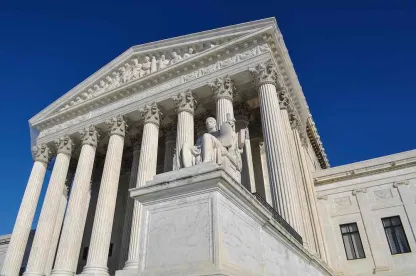Auguring a flood of opinions in the remaining weeks of the term, the Supreme Court decided five cases today. Some of them offer support for the media/popular equation of a political party background with jurisprudential outcomes, but others clearly do not. Interestingly, several cases decided by wide margins also, through concurrences and dissents, lay down markers that could affect the outcomes of future cases.
Let’s start with United States v. Vaello Madero. With only Justice Sotomayor dissenting, the majority of eight joined Justice Kavanaugh’s opinion applying the Constitution’s Territory Clause —which states that Congress may “make all needful Rules and Regulations respecting the Territory . . . belonging to the United States,” Art. IV, §3, cl. 2—and affords Congress broad authority to legislate with respect to the U. S. territories, such as Puerto Rico. Vaello Madero began to receive Supplemental Security Income (SSI) while a resident of New York, and he continued to receive SSI payments when he moved to Puerto Rico, where, by statute, SSI is not available. In upholding the government’s ability to recoup improper payments from the respondent, the Court reiterated that the Constitution does not require Congress to extend SSI benefits to residents of Puerto Rico. Citing Califano v. Torres, 435 U. S. 1, and Harris v. Rosario, 446 U. S. 651, the Court applied the deferential rational-basis test to uphold Congress’s decision not to extend SSI to Puerto Rico, noting that because Congress chose to treat residents of Puerto Rico differently from residents of the States for purposes of tax laws, it could do the same for benefits programs. Justice Sotomayor’s dissent is based upon her argument that the Equal Protection Clause somehow negates the Territory Clause and the Court’s precedents applying a rational-basis test for tax and benefits distinctions. The fact that she stands so far alone in this case demonstrates, once again, that even most liberals, particularly Justice Kagan, who increasingly is influential, will premise their decisions on original meaning and text.
I find more interesting the two concurring opinions. While Justice Thomas joins the majority, he signals that he no longer accepts the premise that the Due Process Clause of the Fifth Amendment contains an equal protection component whose substance is “precisely the same” as the Equal Protection Clause of the Fourteenth Amendment, as was held in Weinberger v. Wiesenfeld, 420 U. S. 636, 638, n. 2 (1975). Instead, he posits that “[f]irmer ground for prohibiting the Federal Government from discriminating on the basis of race, at least with respect to civil rights, may well be found in the Fourteenth Amendment’s Citizenship Clause.” That is plainly a thought that will come up again. Justice Gorsuch, who also joined the majority, concurs separately as well, to sound the death knell of the so-called “Insular Cases,” which held that the federal government could rule Puerto Rico and the other territories without regard to the Constitution. Given the way that the instant case was decided, it was admittedly unnecessary for the Court to overrule the Insular Cases, but Justice Gorsuch nevertheless condemned these racially stereotypical and extra-constitutional opinions.
Boechler, P.C. v. Commissioner of Internal Revenue is a unanimous opinion of the Court, delivered by Justice Barrett, holding that 26 U.S.C. § 6330(d)(1)’s 30-day time limit to file a petition for review of a tax collection due process determination is a non-jurisdictional deadline subject to equitable tolling. Cautioning that not all procedural requirements are jurisdictional, thus not waivable or otherwise subject to equitable exceptions, the Court, applying once again strict textual analysis, found that a procedural requirement is jurisdictional only if Congress “clearly states” that it is. Interestingly, Boechler, P.C., is a law firm, not the sort of individual plaintiff that usually has trouble meeting deadlines. Here, however, its inadvisable lateness has been excused.
Brown v. Davenport is a habeas corpus case, and the 6-3 division of the Justices along strict conservative/liberal lines reflects the hostility that the conservatives have to post-appellate procedural challenges, as it does to the leniency that the liberals would allow particularly in serious felony cases. Brown was convicted of first-degree murder following a jury trial in which he was, at times, visibly shackled and positioned behind a “privacy screen.” He naturally argued that his conviction should be set aside in light of Deck v. Missouri, 544 U. S. 622, in which the Court held that the Fourteenth Amendment’s Due Process Clause generally forbids shackling a criminal defendant at trial absent “a special need.” The Michigan Supreme Court agreed that a Deck violation occurred and that there was no special need, and so remanded the case to the trial court to determine under Chapman v. California, 386 U. S. 18, that the error was harmless. Then, having failed at remand and in subsequent appeals, Davenport petitioned for federal habeas relief. The District Court held that relief was unwarranted under the Antiterrorism and Effective Death Penalty Act of 1996 (AEDPA), which limits the power of federal courts to issue habeas relief to state prisoners. See 28 U. S. C. §2254(d). A divided Sixth Circuit panel reversed, declining to analyze the case under AEDPA, holding that its review was governed only by Brecht v. Abrahamson, 507 U. S. 619, which held that a state prisoner seeking to challenge his conviction on the basis of a state court’s Chapman error must show that the error had a “‘substantial and injurious effect or influence’” on the trial’s outcome. In an opinion by Justice Gorsuch, the Court held that a federal court cannot grant habeas relief without applying both the test this Court outlined in Brecht and the one Congress prescribed in AEDPA. Holding further that Brown could not satisfy AEDPA, the Court reversed the Sixth Circuit. In a sharply worded dissent, Justice Kagan decries what she argues is the majority’s abandonment of recent decisions that Brecht necessarily subsumes AEDPA, and that satisfying the former “necessarily” means that the latter is satisfied. She thus claims that the majority’s analysis “will never lead to a different result” and so contends that its demand is “pointless.”
The Court returned to unanimity in Cassirer v. Thyssen-Bornemisza Collection Foundation. In yet another application of textualism, now adopted by at least two of the liberals, particularly Justice Kagan, who wrote the opinion, the Court analyzed the Foreign Sovereign Immunities Act of 1976 (FSIA), 28 U. S. C. §1602 et seq., which governs whether a foreign state or instrumentality is amenable to suit in an American court, to decide the question of what choice-of-law rule a court should use to determine the applicable substantive law in an FSIA suit raising non-federal claims. Art lovers might know that the case arose in a dispute concerning the ownership of Camille Pissarro’s Impressionist painting: Rue Saint-Honoré in the Afternoon, Effect of Rain. The brief opinion shows that the Court had little trouble concluding that, in an FSIA suit raising non-federal claims against a foreign state or instrumentality, a court should determine the substantive law by using the same choice-of-law rule applicable in a similar suit against a private party—i.e., by applying the forum State’s choice-of-law rule, not a rule deriving from federal common law.
Finally, in a closely watched First Amendment case, though one that has little to do with more-frequent freedom-of-speech issues, the Court decided the much-publicized Austin, Texas, case concerning the regulation of advertising signs. City of Austin v. Reagan National Advertising of Austin, LLC. Austin specially regulates signs that advertise things that are not located at the site of the signs or that direct people to off-site locations. In a suit ultimately removed to federal court, the ad company alleged that Austin’s prohibition against digitizing off-premises signs, but not on-premises signs, violated the First Amendment’s Free Speech Clause. Per Reed v. Town of Gilbert, 576 U. S. 155, the Court, in an opinion written by Justice Sotomayor, held that the City’s distinction between on-premises and off-premises advertising is facially content-neutral and hence was subject to no more than intermediate scrutiny. The essence of the opinion is its conclusion that the City’s regulation did not depend upon any real analysis of its content—i.e., the topic discussed or its substantive message—only upon whether it advertised something on or off the site of the sign. However, the Court held that a determination of facial content-neutrality does not end things, and so remanded the case for considering whether the City had an unlawful purpose in the regulation and whether it was “narrowly tailored” to serve a governmental interest. While the Chief Justice and Justice Kavanaugh, and to some degree Justice Alito, joined the liberals, Justices Thomas, Gorsuch, and Barrett dissented, arguing, if you’ll forgive the expression, more liberally than the supposedly liberal majority, that Austin discriminates in a way that is content-specific, though merely whether signs promote an on- or off-site event, activity, or service. Justice Breyer soon will be retired, but if his former clerk, Judge Ketanji Brown Jackson, follows the reasoning of his concurrence when she is seated on the Court, we might find her joining the three conservative dissenters in future First Amendment cases where strict scrutiny is being argued.
Buckle up for action in the two months to come. As noted, there is a substantial docket waiting for resolution.




 />i
/>i

